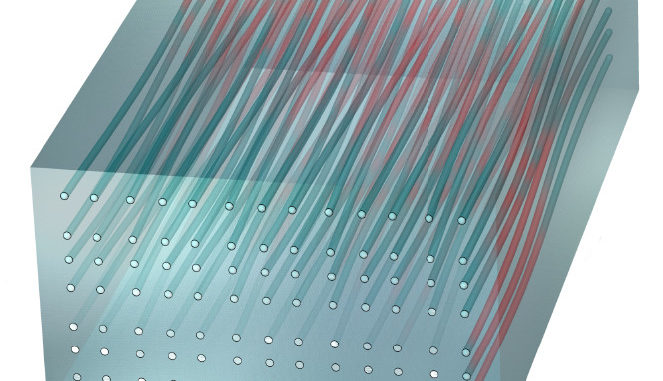
Four-dimensional Physics in Two Dimensions
By: Penn State News
For the first time, physicists have built a two-dimensional experimental system that allows them to study the physical properties of materials that were theorized to exist only in four-dimensional space. An international team of researchers from Penn State, ETH Zurich in Switzerland, the University of Pittsburgh, and the Holon Institute of Technology in Israel have demonstrated that the behavior of particles of light can be made to match predictions about the four-dimensional version of the “quantum Hall effect” — a phenomenon that has been at the root of three Nobel Prizes in physics — in a two-dimensional array of “waveguides.”
A paper describing the research appears Jan. 4 in the journal Nature, along with a paper from a separate group from Germany that shows that a similar mechanism can be used to make a gas of ultracold atoms exhibit four-dimensional quantum Hall physics as well.
“When it was theorized that the quantum Hall effect could be observed in four-dimensional space,” said Mikael Rechtsman, assistant professor of physics and an author of the paper, “it was considered to be of purely theoretical interest because the real world consists of only three spatial dimensions; it was more or less a curiosity. But, we have now shown that four-dimensional quantum Hall physics can be emulated using photons — particles of light — flowing through an intricately structured piece of glass — a waveguide array.”
When electric charge is sandwiched between two surfaces, the charge behaves effectively like a two-dimensional material. When that material is cooled down to near absolute-zero temperature and subjected to a strong magnetic field, the amount that it can conduct becomes “quantized” — fixed to a fundamental constant of nature, and cannot change. “Quantization is striking because even if the material is ‘messy’ — that is, it has a lot of defects — this ‘Hall conductance’ remains exceedingly stable,” said Rechtsman. “This robustness of electron flow — the quantum Hall effect — is universal and can be observed in many different materials under very different conditions.”
This quantization of conductance, first described in two-dimensions, cannot be observed in an ordinary three-dimensional material, but in 2000, it was shown theoretically that a similar quantization could be observed in four spatial dimensions. To model this four-dimensional space, the researchers built waveguide arrays. Each waveguide is essentially a tube, which behaves like a wire for light. This “tube” is inscribed through high-quality glass using a powerful laser.
Many of these waveguides are inscribed closely spaced through a single piece of glass to form the array. The researchers used a recently-developed technique to encode “synthetic dimensions” into the positions of the waveguides. In other words, the complex patterns of the waveguide positions act as a manifestation of the higher-dimensional coordinates. By encoding two extra synthetic dimensions into the complex geometric structure of the waveguides, the researchers were able to model the two-dimensional system as having a total of four spatial dimensions. The researchers then measured how light flowed through the device and found that it behaved precisely according to the predictions of the four-dimensional quantum Hall effect.
“Our observations, taken together with the observations using ultracold atoms, provide the first demonstration of higher-dimensional quantum Hall physics,” said Rechtsman. “But how can understanding and probing higher-dimensional physics have some relevance to science and technology in our three-dimensional world? There are a number of examples where this is the case. For example, ‘quasicrystals’ — metallic alloys that are crystalline but have no repeating units and are used to coat some non-stick pans — have been shown to have ‘hidden dimensions’: Their structures can be understood as projections from higher-dimensional space into the real, three-dimensional world. Furthermore, it is possible that higher-dimensional physics could be used as a design principle for novel photonic devices.”
In addition to Rechtsman, the research team includes Jonathan Guglielmon at Penn State; Oded Zilberberg at ETH Zurich; Sheng Huang, Mohan Wang, and Kevin Chen at the University of Pittsburgh; and Yaacov E. Kraus at the Holon Institute of Technology. The research was supported by the U.S. National Science Foundation, the Charles E. Kaufman Foundation, the Alfred P. Sloan Foundation, and the Swiss National Science Foundation.
Reference:







Leave a Reply